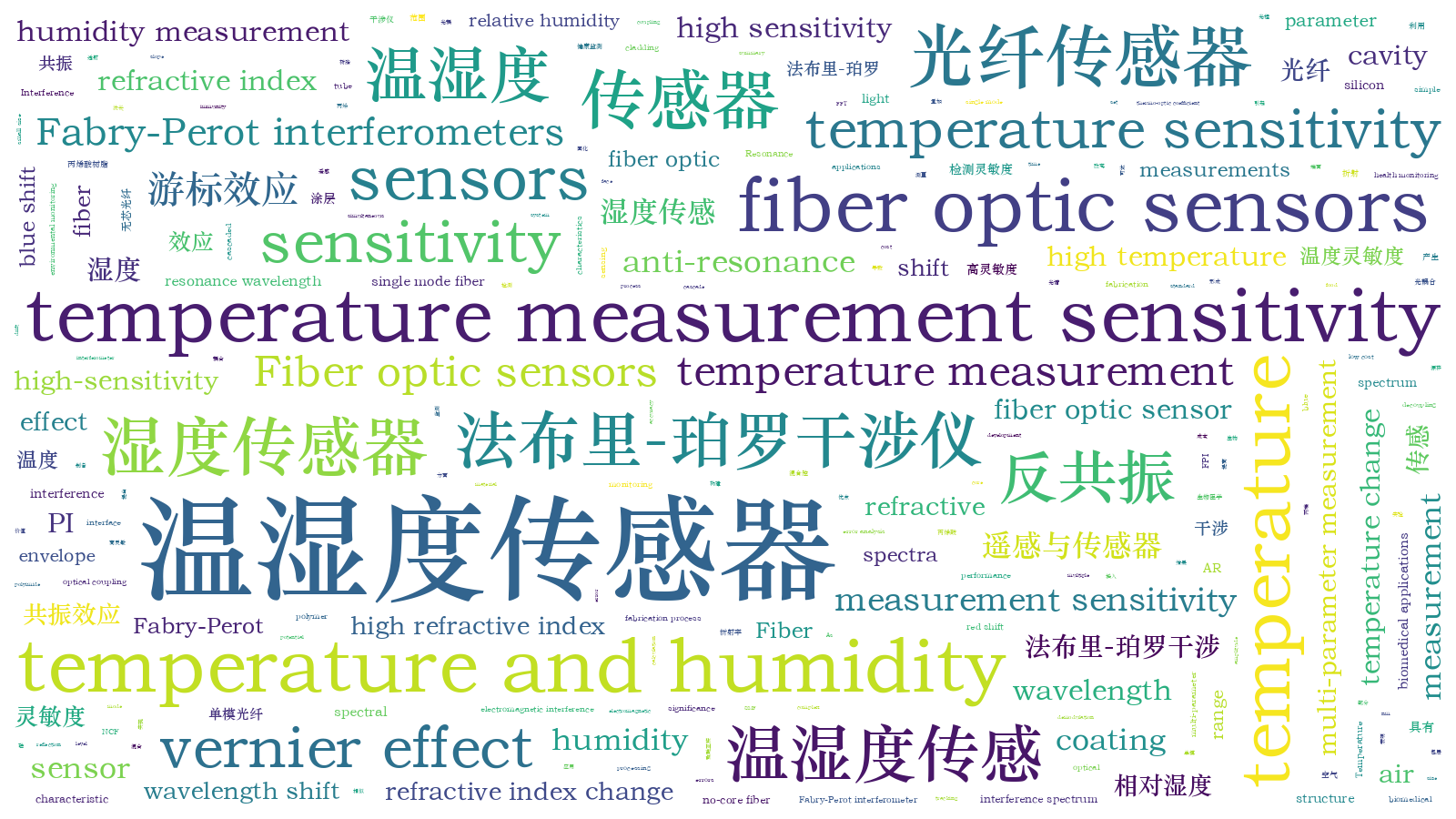基于法布里-珀罗干涉和反共振效应的光纤温湿度传感器
The temperature and relative humidity (RH) measurement plays a crucial role in various fields such as food processing, environmental monitoring, and biomedical applications. Fiber optic sensors have been extensively studied due to their prominent advantages of low cost, small size, strong immunity to electromagnetic interference, and high sensitivity compared to traditional electronic hygrometers. Fiber optic sensors based on the Fabry-Perot interferometer (FPI) structure feature simple fabrication process and stable performance. However, previously proposed fiber optic temperature and humidity sensors exhibit low sensitivity or are limited to single-parameter measurements. Therefore, the development of temperature and humidity dual-parameter sensors with stable performance and high sensitivity holds practical significance. The cascaded structure allows for the connection of multiple fiber optic sensing units, enabling simultaneous multi-parameter measurement. The vernier effect is utilized to amplify the humidity measurement sensitivity, while the anti-resonance (AR) effect of polymer-coated no-core fiber (NCF) provides high temperature measurement sensitivity. We propose and fabricate an FPI cascaded AR temperature and humidity dual-parameter fiber optic sensor, which further enhances the temperature and humidity measurement sensitivity and eliminates the need for complex FFT demodulation processes.
The sensor is composed of cascading an Fabry-Perot (FP) cavity and an NCF with a polymer coating. Meanwhile, the single mode fiber (SMF) and the NCF with polyimide (PI) cured on its end-face are placed into a non-enclosed silicon tube. The non-enclosed silicon allows the humidity-sensitive material PI to have sufficient contact with water molecules in the air. The air cavity is selected as the sensing cavity, while the air-PI mixed cavity serves as the reference cavity. The superimposition of the spectra from the air cavity and the air-PI mixed cavity produces a vernier effect, enabling easy and highly sensitive RH measurement by tracking the spectral envelope of the sensor. The light transmitted through the FP structure further transmits into the NCF. In the NCF segment coated with acrylic resin, the refractive index of the coating is higher than that of the cladding, which causes partial reflection of the light at the interface between the coating and NCF, while the rest is refracted into the coating and reflected at the coating-air interface, which creates MPI inducing the AR effect in the coated NCF. When the external temperature changes, the refractive index of the coating alters, resulting in a wavelength shift of the non-transmitted light for temperature measurement. Real-time temperature and RH can be calculated by adopting a decoupling equation system. The characteristic wavelengths of the reflected and transmitted spectra are measured, and the temperature and RH are simultaneously changed to validate the accuracy of the calculation formula. Additionally, error analysis is performed on the experimental results based on the set standard values, with RH and temperature relative errors of 0.74% and 0.19% respectively, which indicates that the sensor has a certain level of practicality.
Under the temperature of 29.5 ℃, the sensor's spectral drift characteristics are tested as the RH increases from 10% to 80% (Fig. 5). As the humidity grows, the resonance wavelength of the FPI envelope shifts towards longer wavelengths, with the RH sensitivity of 510.25 pm/%. The characteristic wavelength of the AR spectrum shows a red shift in the range of 10% to 60% and a blue shift in the range of 60% to 80%. With the humidity kept at 33%, the temperature is increased from 26 ℃ to 35 ℃, and the interference spectrum wavelength is recorded every 1 ℃ (Fig. 6). The envelope wavelength of FPI interference spectra remains unchanged with the rising temperature. Due to the high thermo-optic coefficient of the acrylic resin, the temperature change alters the refractive index of the coating, affecting the non-transmitted wavelength. The characteristic wavelength of the AR spectrum shows a blue shift with increasing temperature and exhibits amplitude variations with a slope of -4.48 nm/℃.
We present a high-sensitivity cascade sensor based on FPI and AR effects for temperature and RH measurement. The sensor incorporates an SMF with a PI film-coated NCF that is inserted into an open-ended silicon tube. By superimposing two FPI spectra with similar optical paths, a vernier effect is generated to amplify the sensor's low sensitivity. The high-sensitivity RH measurement is achieved by detecting the envelope movement. The AR effect is formed by the optical coupling of the NCF high refractive index acrylic resin coating and the low refractive index cladding, which produces a shift in the non-transmitted wavelength due to the refractive index change of the coating caused by temperature. The experimental results show that within the range of 10% to 80%, the RH sensitivity is 510.25 pm/%, which amplifies the original sensitivity by approximately five times. In the range of 26 ℃ to 35 ℃, the temperature sensitivity is -4.48 nm/℃. In summary, the proposed sensor features simple fabrication and high sensitivity and holds potential practical significance in such fields as health monitoring and biomedical applications.
胡子怡, 常建华, 金澳博, 陈鸣, 徐遥. 基于法布里-珀罗干涉和反共振效应的光纤温湿度传感器[J]. 光学学报, 2024, 44(5): 0528001. Ziyi Hu, Jianhua Chang, Aobo Jin, Ming Chen, Yao Xu. Fiber-Optic Temperature and Humidity Sensor Based on Fabry-Perot Interference and Anti-Resonance Effect[J]. Acta Optica Sinica, 2024, 44(5): 0528001.







